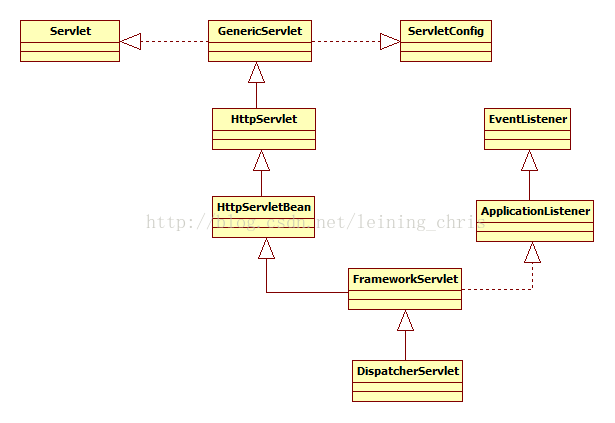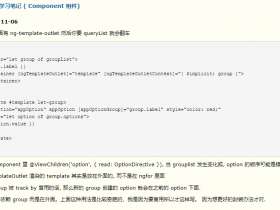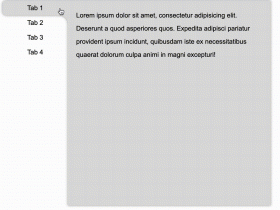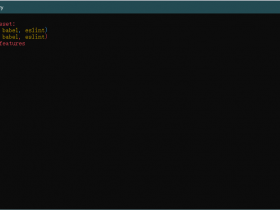- A+
DispatcherServlet类结构图

DispatcherServlet源码分析
1. 加载配置文件
/** * This implementation calls {@link #initStrategies}. */ @Override protected void onRefresh(ApplicationContext context) { initStrategies(context); } /** * 初始化定位解析器、主题解析器、处理器映射器、处理器适配器、异常解析器、视图解析器等等 */ protected void initStrategies(ApplicationContext context) { initMultipartResolver(context); initLocaleResolver(context); initThemeResolver(context); initHandlerMappings(context); initHandlerAdapters(context); initHandlerExceptionResolvers(context); initRequestToViewNameTranslator(context); initViewResolvers(context); initFlashMapManager(context); }
initStrategies()方法我们可以看出DispatcherServlet实例化时会初始化web层相关的bean,如HandlerMapping,HandlerAdapter等,并且如果我们没有进行配置,DispatcherServlet会提供默认的配置。以上的Servlet的体系结构以及DispatcherServlet的实例化过程我们可以看出主要完成以下几个事情:
(1)通过配置Servlet实现SpringMVC核心控制器DispatcherServlet的初始化;
(2)通过ServletContext共享Spring根上下文,使得每一个Servlet实例获取根上下文中的bean,用于实例化SpringMVC web层的相关bean。
(3)初始化DispatcherServlet作为核心控制器,接收处理请求需要的相关资源,如HandlerMapping,HandlerAdapter等。
(4)通过Servlet体系结构中的继承关系以及抽象方法,可以根据具体的需求对各个层级的Servlet抽象方法进行重写以满足不同的功能需要,父类中只定义流程和方法引用,具体实现由子Servlet完成,实现定义与实现的分离,便于扩展。
2. processRequest()方法
@Override protected final void doGet(HttpServletRequest request, HttpServletResponse response) throws ServletException, IOException { processRequest(request, response); } protected final void processRequest(HttpServletRequest request, HttpServletResponse response) throws ServletException, IOException { long startTime = System.currentTimeMillis(); Throwable failureCause = null; // Expose current LocaleResolver and request as LocaleContext. LocaleContext previousLocaleContext = LocaleContextHolder.getLocaleContext(); LocaleContextHolder.setLocaleContext(buildLocaleContext(request), this.threadContextInheritable); // Expose current RequestAttributes to current thread. RequestAttributes previousRequestAttributes = RequestContextHolder.getRequestAttributes(); ServletRequestAttributes requestAttributes = null; if (previousRequestAttributes == null || previousRequestAttributes.getClass().equals(ServletRequestAttributes.class)) { requestAttributes = new ServletRequestAttributes(request); RequestContextHolder.setRequestAttributes(requestAttributes, this.threadContextInheritable); } if (logger.isTraceEnabled()) { logger.trace("Bound request context to thread: " + request); } try { doService(request, response); } catch (ServletException ex) { failureCause = ex; throw ex; } catch (IOException ex) { failureCause = ex; throw ex; } catch (Throwable ex) { failureCause = ex; throw new NestedServletException("Request processing failed", ex); } finally { // Clear request attributes and reset thread-bound context. LocaleContextHolder.setLocaleContext(previousLocaleContext, this.threadContextInheritable); if (requestAttributes != null) { RequestContextHolder.setRequestAttributes(previousRequestAttributes, this.threadContextInheritable); requestAttributes.requestCompleted(); } if (logger.isTraceEnabled()) { logger.trace("Cleared thread-bound request context: " + request); } if (logger.isDebugEnabled()) { if (failureCause != null) { this.logger.debug("Could not complete request", failureCause); } else { this.logger.debug("Successfully completed request"); } } if (this.publishEvents) { // Whether or not we succeeded, publish an event. long processingTime = System.currentTimeMillis() - startTime; this.webApplicationContext.publishEvent( new ServletRequestHandledEvent(this, request.getRequestURI(), request.getRemoteAddr(), request.getMethod(), getServletConfig().getServletName(), WebUtils.getSessionId(request), getUsernameForRequest(request), processingTime, failureCause)); } } }
DispatcherServlet也是通过自己的service()方法来接收和转发Http请求到具体的doGet()或doPost()这些方法的。以一次典型的GET请求为例,经过HttpServlet基类中service()方法的委派,请求会被转发到doGet()方法中。doGet()方法,在DispatcherServlet的父类FrameworkServlet类中被覆写。
processRequest()方法理解的要点是以doService()方法为区隔,前一部分是将当前请求的Locale对象和属性,分别设置到LocaleContextHolder和RequestContextHolder这两个抽象类中的ThreadLocal对象中,也就是分别将这两个东西和请求线程做了绑定。在doService()处理结束后,再恢复回请求前的LocaleContextHolder和RequestContextHolder,也即解除线程绑定。每次请求处理结束后,容器上下文都发布了一个ServletRequestHandledEvent事件,你可以注册监听器来监听该事件。
可以看到,processRequest()方法只是做了一些线程安全的隔离,真正的请求处理,发生在doService()方法中。
3. doService()方法
@Override protected void doService(HttpServletRequest request, HttpServletResponse response) throws Exception { if (logger.isDebugEnabled()) { String requestUri = urlPathHelper.getRequestUri(request); logger.debug("DispatcherServlet with name '" + getServletName() + "' processing " + request.getMethod() + " request for [" + requestUri + "]"); } // Keep a snapshot of the request attributes in case of an include, // to be able to restore the original attributes after the include. Map<string, object=""> attributesSnapshot = null; if (WebUtils.isIncludeRequest(request)) { logger.debug("Taking snapshot of request attributes before include"); attributesSnapshot = new HashMap<string, object="">(); Enumeration attrNames = request.getAttributeNames(); while (attrNames.hasMoreElements()) { String attrName = (String) attrNames.nextElement(); if (this.cleanupAfterInclude || attrName.startsWith("org.springframework.web.servlet")) { attributesSnapshot.put(attrName, request.getAttribute(attrName)); } } } // Make framework objects available to handlers and view objects. request.setAttribute(WEB_APPLICATION_CONTEXT_ATTRIBUTE, getWebApplicationContext()); request.setAttribute(LOCALE_RESOLVER_ATTRIBUTE, this.localeResolver); request.setAttribute(THEME_RESOLVER_ATTRIBUTE, this.themeResolver); request.setAttribute(THEME_SOURCE_ATTRIBUTE, getThemeSource()); FlashMap inputFlashMap = this.flashMapManager.retrieveAndUpdate(request, response); if (inputFlashMap != null) { request.setAttribute(INPUT_FLASH_MAP_ATTRIBUTE, Collections.unmodifiableMap(inputFlashMap)); } request.setAttribute(OUTPUT_FLASH_MAP_ATTRIBUTE, new FlashMap()); request.setAttribute(FLASH_MAP_MANAGER_ATTRIBUTE, this.flashMapManager); try { doDispatch(request, response); //这边最终也是调用了doDispatch方法,该方法主要用来处理SPring框架的具体业务分发逻辑。 } finally { // Restore the original attribute snapshot, in case of an include. if (attributesSnapshot != null) { restoreAttributesAfterInclude(request, attributesSnapshot); } } }
doService()方法中requet.setAttribute()方法的调用,将前面在初始化流程中实例化的对象设置到http请求的属性中,供下一步处理使用,其中有容器的上下文对象、本地化解析器等SpringMVC特有的编程元素。不同于Struts2中的ValueStack,SpringMVC的数据并没有从HttpServletRequest对象中抽离出来再存进另外一个编程元素,这也跟SpringMVC的设计思想有关。因为从一开始,SpringMVC的设计者就认为,不应该将请求处理过程和Web容器完全隔离。所以,真正发生请求转发的方法doDispatch()中,它的参数是HttpServletRequest和HttpServletResponse对象。
4. doDispatch()方法
//Spring框架最终的分发都是通过该方法的 protected void doDispatch(HttpServletRequest request, HttpServletResponse response) throws Exception { HttpServletRequest processedRequest = request; HandlerExecutionChain mappedHandler = null; int interceptorIndex = -1; try { ModelAndView mv; boolean errorView = false; try { processedRequest = checkMultipart(request); // Determine handler for the current request. mappedHandler = getHandler(processedRequest, false); if (mappedHandler == null || mappedHandler.getHandler() == null) { noHandlerFound(processedRequest, response); return; } // Determine handler adapter for the current request. HandlerAdapter ha = getHandlerAdapter(mappedHandler.getHandler()); // Process last-modified header, if supported by the handler. String method = request.getMethod(); boolean isGet = "GET".equals(method); if (isGet || "HEAD".equals(method)) { long lastModified = ha.getLastModified(request, mappedHandler.getHandler()); if (logger.isDebugEnabled()) { String requestUri = urlPathHelper.getRequestUri(request); logger.debug("Last-Modified value for [" + requestUri + "] is: " + lastModified); } if (new ServletWebRequest(request, response).checkNotModified(lastModified) && isGet) { return; } } // 这里是处理前置拦截器 HandlerInterceptor[] interceptors = mappedHandler.getInterceptors(); if (interceptors != null) { for (int i = 0; i < interceptors.length; i++) { HandlerInterceptor interceptor = interceptors[i]; if (!interceptor.preHandle(processedRequest, response, mappedHandler.getHandler())) { triggerAfterCompletion(mappedHandler, interceptorIndex, processedRequest, response, null); return; } interceptorIndex = i; } } //处理最终的Action逻辑 mv = ha.handle(processedRequest, response, mappedHandler.getHandler()); // Do we need view name translation? if (mv != null && !mv.hasView()) { mv.setViewName(getDefaultViewName(request)); } //处理后置拦截器 if (interceptors != null) { for (int i = interceptors.length - 1; i >= 0; i--) { HandlerInterceptor interceptor = interceptors[i]; interceptor.postHandle(processedRequest, response, mappedHandler.getHandler(), mv); } } } catch (ModelAndViewDefiningException ex) { logger.debug("ModelAndViewDefiningException encountered", ex); mv = ex.getModelAndView(); } catch (Exception ex) { Object handler = (mappedHandler != null ? mappedHandler.getHandler() : null); mv = processHandlerException(processedRequest, response, handler, ex); errorView = (mv != null); } // Did the handler return a view to render? if (mv != null && !mv.wasCleared()) { render(mv, processedRequest, response); if (errorView) { WebUtils.clearErrorRequestAttributes(request); } } else { if (logger.isDebugEnabled()) { logger.debug("Null ModelAndView returned to DispatcherServlet with name '" + getServletName() + "': assuming HandlerAdapter completed request handling"); } } // Trigger after-completion for successful outcome. triggerAfterCompletion(mappedHandler, interceptorIndex, processedRequest, response, null); } catch (Exception ex) { // Trigger after-completion for thrown exception. triggerAfterCompletion(mappedHandler, interceptorIndex, processedRequest, response, ex); throw ex; } catch (Error err) { ServletException ex = new NestedServletException("Handler processing failed", err); // Trigger after-completion for thrown exception. triggerAfterCompletion(mappedHandler, interceptorIndex, processedRequest, response, ex); throw ex; } finally { // Clean up any resources used by a multipart request. if (processedRequest != request) { cleanupMultipart(processedRequest); } } }
doDispatch()是整个请求转发流程中最核心的方法,DispatcherServlet所接收的Http请求,经过层层转发,最终都是汇总到这个方法中来进行最后的请求分发和处理。它通过高度抽象的接口,描述出了一个MVC(Model-View-Controller)设计模式的实现方案。Model、View、Controller三种层次的编程元素,在SpringMVC中都有大量的实现类,各种处理细节也是千差万别。但是,它们最后都是由,也都能由doDispatch()方法来统一描述,这就是接口和抽象的威力,万变不离其宗。




